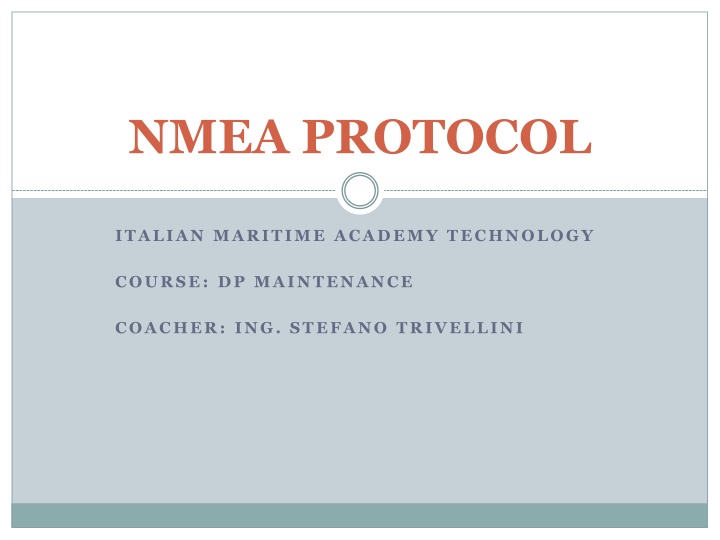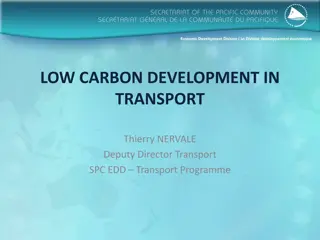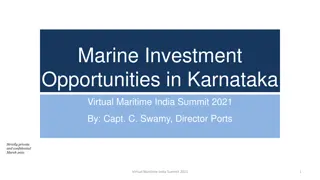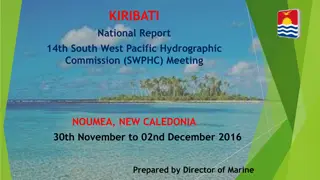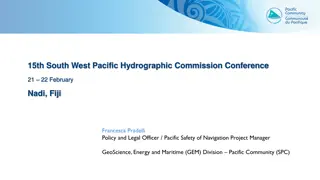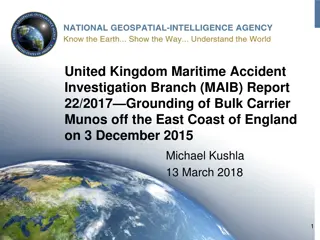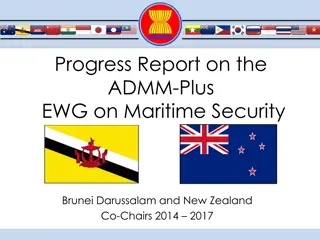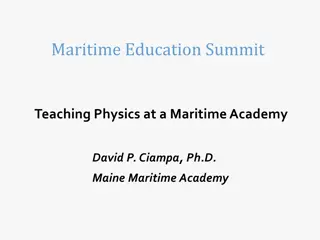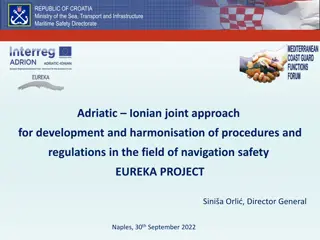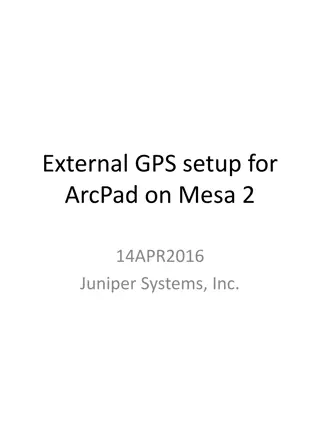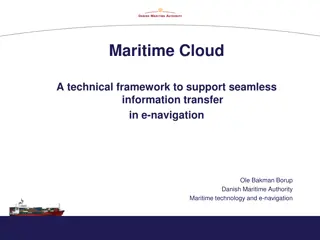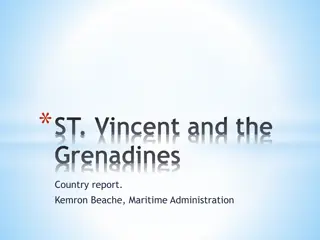NMEA Protocol in Maritime Technology
The NMEA Protocol, defined by the National Marine Electronics Association (NMEA), sets standards for communication among marine instrumentation. NMEA 0183, a key standard, establishes electrical interfaces in marine electronics. Additionally, NMEA 2000 introduces a new standard for shipboard electronic devices. The protocol specifies parameters for devices like baud rate, data bits, and more. Talkers and listeners are categorized in NMEA 0183, facilitating communication on circuits with recommended wiring. Complying with EIA RS-422 is recommended for talker outputs to enhance signal immunity to noise.
Uploaded on Sep 23, 2024 | 2 Views
Download Presentation

Please find below an Image/Link to download the presentation.
The content on the website is provided AS IS for your information and personal use only. It may not be sold, licensed, or shared on other websites without obtaining consent from the author.If you encounter any issues during the download, it is possible that the publisher has removed the file from their server.
You are allowed to download the files provided on this website for personal or commercial use, subject to the condition that they are used lawfully. All files are the property of their respective owners.
The content on the website is provided AS IS for your information and personal use only. It may not be sold, licensed, or shared on other websites without obtaining consent from the author.
E N D
Presentation Transcript
NMEA PROTOCOL ITALIAN MARITIME ACADEMY TECHNOLOGY COURSE: DP MAINTENANCE COACHER: ING. STEFANO TRIVELLINI
NMEA PROTOCOL The National Marine Electronics Association (NMEA) is a non-profit association distributors, dealers, educational institutions, and others interested in peripheral marine electronics occupations. The NMEA 0183 standard defines an electrical interface and communications between marine instrumentation. NMEA 0183 is a voluntary industry standard, first released in March of 1983. It has been updated from time to time; the latest release, currently (August 2001) Version 3.0, July 2001. of manufacturers, data protocol for
NMEA PROTOCOL NMEA has also established a working group to develop a new standard for data communications among shipboard electronic devices. The new standard, NMEA 2000, is a bi-directional, multi-transmitter, multi-receiver serial data network. It is multi-master and self-configuring, and controller. The NMEA began a beta testing period in January 2000 with eleven manufacturers. A release version of NMEA 2000 is expected in 2001. there is no central
NMEA PROTOCOL NMEA 0183 devices are designated as either talkers or listeners (with some devices being both), employing an asynchronous serial interface with the following parameters: Baud rate: 4800 bit/s Number of data bits: 8 (bit 7 is 0) Stop bits: 1 (or more) Parity: none Handshake: none
NMEA PROTOCOL NMEA 0183 allows a single talker and several listeners on one circuit. The recommended interconnect wiring is a shielded twisted pair, with the shield grounded only at the talker. The standard dos not specify the use of a particular connector. Note: The new 0183-HS standard introduced in version 3.0 uses a 3-wire interface and a baud rate of 38400. This type of interface is not discussed here. (HS = high speed)
NMEA PROTOCOL Its is recommended that the talker output comply with EIA RS-422, a differential system with two signal lines, "A" and "B". Differential drive signals have no reference to ground and are more immune to noise. However, a single-ended line at TTL level is accepted as well. The voltages on the A line correspond to those on the TTL single wire, while the B voltages are inverted (when output A is at +5 V, output B is at 0 V, and vice versa. This is the unipolar RS-422 operation. In bipolar mode 5 V are used).
NMEA PROTOCOL In either case, the recommended receive circuit uses an opto-isolator with suitable protection circuitry. The input should be isolated from the receiver's ground. In practice, the single wire, or the RS-422 "A wire may be directly connected to a computer's RS-232 input. In fact even many of the latest products, like hand-held GPS receivers, do not have a RS-422 differential output, but just a single line with TTL or 5 V CMOS compatible signal level.
NMEA PROTOCOL GENERAL SENTENCE FORMAT
NMEA PROTOCOL All data is transmitted in the form of sentences. Only printable ASCII characters are allowed, plus CR (carriage return) and LF (line feed). Each sentence starts with a "$" sign and ends with <CR><LF>. There are three basic kinds of sentences: talker sentences, proprietary sentences. Talker Sentences. The general format for a talker sentence is: $ttsss,d1,d2,....<CR><LF> sentences and query
NMEA PROTOCOL The first two letters following the $ are the talker identifier. The next three characters (sss) are the sentence identifier, followed by a number of data fields separated by commas, followed by an optional checksum, and terminated by carriage return/line feed. The data fields are uniquely defined for each sentence type. An example talker sentence is: $HCHDM,238,M<CR><LF> where "HC" specifies the talker as being a magnetic compass, the "HDM" specifies the magnetic heading message follows. The "238" is the heading value, and "M" designates the heading value as magnetic.
NMEA PROTOCOL A sentence may contain up to 80 characters plus "$ and CR/LF. If data for a field is not available, the field is omitted, but the delimiting commas are still sent, with no space between them. The checksum field consists of a "*" and two hex digits representing the exclusive OR of all characters between, but not including, the "$" and "*".
NMEA PROTOCOL Proprietary Sentences. The standard allows individual manufacturers to define proprietary sentence formats. These sentences start with "$P", then a 3 letter manufacturer ID, followed by whatever data the manufacturer wishes, following the general format of the standard sentences. Some proprietary sentences, mainly from Garmin, Inc., are listed in chapter 6.
NMEA PROTOCOL Query sentences. A query sentence is a means for a listener to request a particular sentence from a talker. The general format is: $ttllQ,sss,[CR][LF] The first two characters of the address field are the talker identifier of the requester and the next two characters are the talker identifier of the device being queried (listener). The fifth character is always a "Q defining the message as a query. The next field (sss) contains the three letter mnemonic of the sentence being requested. An example query sentence is: $CCGPQ,GGA<CR><LF> where the "CC" device (computer) is requesting from the "GP" device (a GPS unit) the "GGA" sentence. The GPS will then transmit this sentence once per second until a different query isrequested.
NMEA PROTOCOL Talker Identifiers II Integrated Instrumentation IN Integrated Navigation LC Loran C P Proprietary Code RA RADAR and/or ARPA SD Sounder, Depth SN Electronic Positioning System, other/general SS Sounder, Scanning TI Turn Rate Indicator VD Velocity Sensor, Doppler, other/general DM Velocity Sensor, Speed Log, Water, Magnetic VW Velocity Sensor, Speed Log, Water, Mechanical WI Weather Instruments YX Transducer ZA Timekeeper Atomic Clock ZC Timekeeper Chronometer ZQ Timekeeper Quartz ZV Timekeeper Radio Update, WWV or WWVH AG Autopilot - General AP Autopilot - Magnetic CD Communications Digital Selective Calling (DSC) CR Communications Receiver / Beacon Receiver CS Communications Satellite CT Communications Radio-Telephone (MF/HF) CV Communications Radio-Telephone (VHF) CX Communications Scanning Receiver DF Direction Finder EC Electronic Chart Display & Information System (ECDIS) EP Emergency Position Indicating Beacon (EPIRB) ER Engine Room Monitoring Systems GP Global Positioning System (GPS) HC Heading Magnetic Compass HE Heading North Seeking Gyro HN Heading Non North Seeking Gyro
NMEA PROTOCOL Sentence Identifiers and Formats GGA Global Positioning System Fix Data. Time, Position and fix related data for a GPS receiver 1 2 3 4 5 6 7 8 9 10 11 12 13 14 15 | | | | | | | | | | | | | | | $--GGA,hhmmss.ss,llll.ll,a,yyyyy.yy,a,x,xx,x.x,x.x,M,x.x,M,x.x,xxxx*hh 1) Time (UTC) 2) Latitude 3) N or S (North or South) 4) Longitude 5) E or W (East or West) 6) GPS Quality Indicator, 0 - fix not available, 1 - GPS fix, 2 - Differential GPS fix 7) Number of satellites in view, 00 - 12 8) Horizontal Dilution of precision 9) Antenna Altitude above/below mean-sea-level (geoid) 10) Units of antenna altitude, meters 11) Geoidal separation, the difference between the WGS-84 earth ellipsoid and mean-sea-level (geoid), "-" means mean-sea-level below ellipsoid 12) Units of geoidal separation, meters 13) Age of differential GPS data, time in seconds since last SC104 type 1 or 9 update, null field when DGPS is not used 14) Differential reference station ID, 0000-1023 15) Checksum
